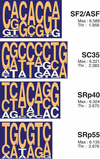ESEfinder: A web resource to identify exonic splicing enhancers - PubMed (original) (raw)
ESEfinder: A web resource to identify exonic splicing enhancers
Luca Cartegni et al. Nucleic Acids Res. 2003.
Abstract
Point mutations frequently cause genetic diseases by disrupting the correct pattern of pre-mRNA splicing. The effect of a point mutation within a coding sequence is traditionally attributed to the deduced change in the corresponding amino acid. However, some point mutations can have much more severe effects on the structure of the encoded protein, for example when they inactivate an exonic splicing enhancer (ESE), thereby resulting in exon skipping. ESEs also appear to be especially important in exons that normally undergo alternative splicing. Different classes of ESE consensus motifs have been described, but they are not always easily identified. ESEfinder (http://exon.cshl.edu/ESE/) is a web-based resource that facilitates rapid analysis of exon sequences to identify putative ESEs responsive to the human SR proteins SF2/ASF, SC35, SRp40 and SRp55, and to predict whether exonic mutations disrupt such elements.
Figures
Figure 1
Pictograms (1) representing the functional-SELEX consensus ESE motifs. The height of each letter reflects the frequency of each nucleotide at a given position, after adjusting for background nucleotide composition. At each position, the nucleotides are shown from top to bottom in order of decreasing frequency; orange letters indicate above-background frequencies. For each motif, the threshold value and the highest possible score are provided.
Figure 2
Example of ESEfinder input and output windows. (A) Input window. Two query sequences, BRCA1 exon 18 and a single point mutation variant (E1694X) are shown. All four matrices and their default threshold values were selected. Additional information is available from the tab links. (B) Output window. High scores, tabulated under each SR protein, are listed. Note that an SF2/ASF high score (arrow) has been abrogated by the mutation. (C) Output window with complete list of scores. (D) Graphic output window. High scores are represented as color-coded bars. The height of each bar indicates the score value, and its width and placement on the _x_-axis represent the length of the motif (6–8 nt) and its position along the sequence.
Similar articles
- Distribution of SR protein exonic splicing enhancer motifs in human protein-coding genes.
Wang J, Smith PJ, Krainer AR, Zhang MQ. Wang J, et al. Nucleic Acids Res. 2005 Sep 7;33(16):5053-62. doi: 10.1093/nar/gki810. Print 2005. Nucleic Acids Res. 2005. PMID: 16147989 Free PMC article. - Identification of functional exonic splicing enhancer motifs recognized by individual SR proteins.
Liu HX, Zhang M, Krainer AR. Liu HX, et al. Genes Dev. 1998 Jul 1;12(13):1998-2012. doi: 10.1101/gad.12.13.1998. Genes Dev. 1998. PMID: 9649504 Free PMC article. - RESCUE-ESE identifies candidate exonic splicing enhancers in vertebrate exons.
Fairbrother WG, Yeo GW, Yeh R, Goldstein P, Mawson M, Sharp PA, Burge CB. Fairbrother WG, et al. Nucleic Acids Res. 2004 Jul 1;32(Web Server issue):W187-90. doi: 10.1093/nar/gkh393. Nucleic Acids Res. 2004. PMID: 15215377 Free PMC article. - Exonic splicing enhancers: mechanism of action, diversity and role in human genetic diseases.
Blencowe BJ. Blencowe BJ. Trends Biochem Sci. 2000 Mar;25(3):106-10. doi: 10.1016/s0968-0004(00)01549-8. Trends Biochem Sci. 2000. PMID: 10694877 Review. - Exonic Variants that Affect Splicing - An Opportunity for "Hidden" Mutations Causing Inherited Retinal Diseases.
Sundaresan Y, Banin E, Sharon D. Sundaresan Y, et al. Adv Exp Med Biol. 2023;1415:183-187. doi: 10.1007/978-3-031-27681-1_27. Adv Exp Med Biol. 2023. PMID: 37440032 Review.
Cited by
- Global transcriptome modulation by xenobiotics: the role of alternative splicing in adaptive responses to chemical exposures.
Annalora AJ, Coburn JL, Jozic A, Iversen PL, Marcus CB. Annalora AJ, et al. Hum Genomics. 2024 Nov 18;18(1):127. doi: 10.1186/s40246-024-00694-6. Hum Genomics. 2024. PMID: 39558396 - Genetic and functional analyses of CTBP2 in anorexia nervosa and body weight regulation.
Giuranna J, Zheng Y, Brandt M, Jall S, Mukherjee A, Shankhwar S, Renner S, Kurapati NK, May C, Peters T, Herpertz-Dahlmann B, Seitz J, de Zwaan M, Herzog W, Ehrlich S, Zipfel S, Giel K, Egberts K, Burghardt R, Föcker M, Marcus K, Keyvani K, Müller TD, Schmitz F, Rajcsanyi LS, Hinney A. Giuranna J, et al. Mol Psychiatry. 2024 Nov 7. doi: 10.1038/s41380-024-02791-3. Online ahead of print. Mol Psychiatry. 2024. PMID: 39511451 - A novel ITGB8 transcript variant sustains ovarian cancer cell survival through genomic instability and altered ploidy on a mutant p53 background.
Narayanan A, More AS, Talreja M, Mali AM, Vinay SB, Bapat SA. Narayanan A, et al. J Ovarian Res. 2024 Nov 6;17(1):218. doi: 10.1186/s13048-024-01538-6. J Ovarian Res. 2024. PMID: 39506768 Free PMC article. - From computational models of the splicing code to regulatory mechanisms and therapeutic implications.
Capitanchik C, Wilkins OG, Wagner N, Gagneur J, Ule J. Capitanchik C, et al. Nat Rev Genet. 2024 Oct 2. doi: 10.1038/s41576-024-00774-2. Online ahead of print. Nat Rev Genet. 2024. PMID: 39358547 Review. - Uncovering recessive alleles in rare Mendelian disorders by genome sequencing of 174 individuals with monoallelic pathogenic variants.
Schobers G, Pennings M, de Vries J, Kwint M, van Reeuwijk J, Corominas Galbany J, van Beek R, Kamping E, Timmermans R, Kamsteeg EJ, Haer-Wigman L, Cremers FPM, Roosing S, Gilissen C, Kremer H, Brunner HG, Yntema HG, Vissers LELM. Schobers G, et al. Eur J Hum Genet. 2024 Sep 27. doi: 10.1038/s41431-024-01694-9. Online ahead of print. Eur J Hum Genet. 2024. PMID: 39333430
References
- Burge C.B., Tuschl,T. and Sharp,P.A. (1999) Splicing of precursors to messenger RNAs by the spliceosome. In Gesteland,R.F., Cech,T.R. and Atkins,J.F. (eds) The RNA World II, Cold Spring Harbor Laboratory Press, Cold Spring Harbor, NY, pp. 525–560.
- Cartegni L., Chew,S.L. and Krainer,A.R. (2002) Listening to silence and understanding nonsense: exonic mutations that affect splicing. Nature Rev. Genet., 3, 285–298. - PubMed
- Maniatis T. and Tasic,B. (2002) Alternative pre-mRNA splicing and proteome expansion in metazoans. Nature, 418, 236–243. - PubMed
Publication types
MeSH terms
Substances
Grants and funding
- R37 GM042699/GM/NIGMS NIH HHS/United States
- CA88351/CA/NCI NIH HHS/United States
- HG01696/HG/NHGRI NIH HHS/United States
- R33 CA088351/CA/NCI NIH HHS/United States
- R01 GM042699/GM/NIGMS NIH HHS/United States
- GM42699/GM/NIGMS NIH HHS/United States
- R01 HG001696/HG/NHGRI NIH HHS/United States
- R21 CA088351/CA/NCI NIH HHS/United States
LinkOut - more resources
Full Text Sources
Other Literature Sources
Research Materials

